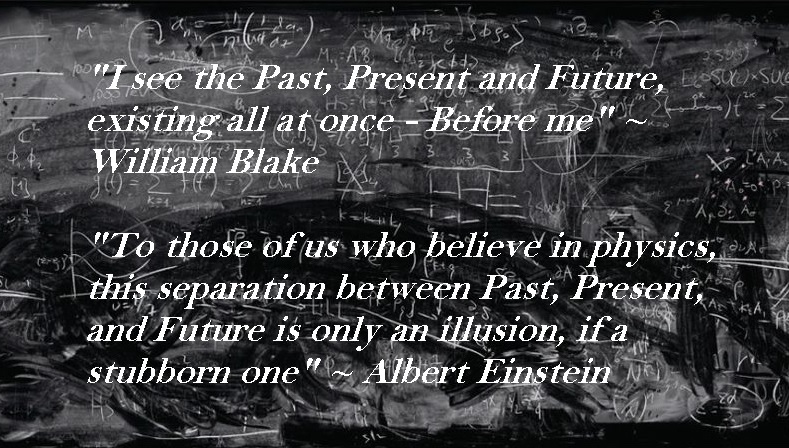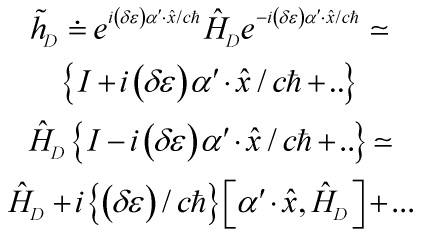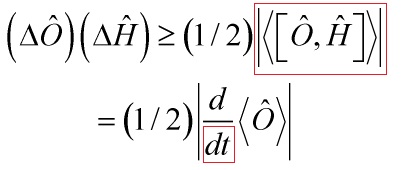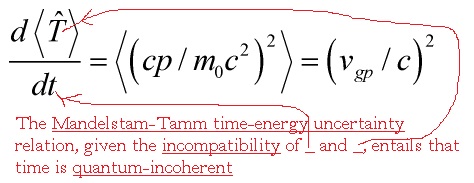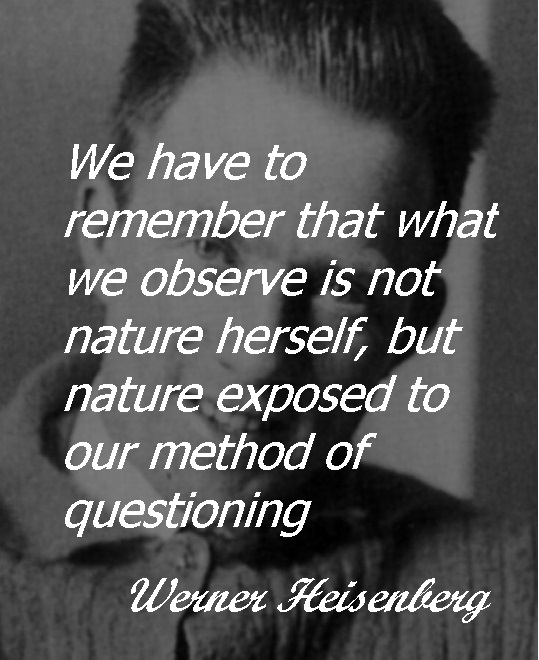The problem of ‘time’ (PoT) in physics is as varied as there are interpretations of the formalism of quantum mechanics. I shall set up the two hardest aspects of the problem and expand and delve deeper in subsequent writings. A familiar summation of the problem is in terms of the dichotomy between time as a Schrödinger-parameter as opposed to a ‘dynamical’-M-operator, as well as how that collides with time as it occurs in quantum cosmology, and before discussing the foundational problem, here is how time can be seen as paradoxical. The deepest aspect of the PoT is revealed in any canonical or backround-independent attempt at quantizing GR: and that is the problem of a constraint that is quadratic in the momenta however contains no linear dependence on the momenta. To visualize, here is the Wheeler–DeWitt equation (WdW)
and for GR, the Hamiltonian constraint is
and elevating any equation with a momentum dependence of the above kind to the quantum level cannot give a time-dependent wave equation such as
![]()
for a place-holder ‘t’ and some quantum Hamiltonian as one ought to expect, but paradoxically, a stationary-frozen-timeless equation
![]()
and as can be seen by interpreting the above WdW-equation, time ‘disappears’! This is a paradox, unlike attempts to explain it away by distinguishing cosmic versus micro-subsystems ‘within’ the universe not subject to the WdW-WE, and the reason being that in Dirac’s relativistic quantum mechanics formalism, one can introduce a dynamical time operator
![]()
that is self-adjoint and does generate a unitary transformation
![]()
and the Dirac Hamiltonian eigenvalue equation
![]()
holding and it gives
![]()
as
![]()
with the ‘time eigenvectors’ being
![]()
for i = 1, 2, 3, 4, … and ![]() is an invariant quantity in the
is an invariant quantity in the ![]() space as
space as ![]() in the
in the ![]() space:
space:
![]()
noting that ![]() is ‘real’ and has the dimensions of the energy of the system under consideration. Here is where things get paradoxical: first note, for infinitesimal transformations
is ‘real’ and has the dimensions of the energy of the system under consideration. Here is where things get paradoxical: first note, for infinitesimal transformations ![]() , we can write
, we can write
as
![]()
Thus, the Hamiltonian becomes
To set up the PoT, consider
Now using
![]()
we get
![Rendered by QuickLaTeX.com \[\begin{array}{c}\left[ {\alpha ' \cdot \hat x,{{\hat H}_D}} \right] = 3ic\hbar I + 2{{\hat H}_D} \cdot \\\left\{ {\alpha ' - c\hat p/{{\hat H}_D}} \right\} \cdot \hat r\end{array}\]](https://www.georgeshiber.com/wp-content/ql-cache/quicklatex.com-ad586b1c8136d6d27e4dc9e2505c230a_l3.png)
Hence, the unitary transformation induces a shift in momentum by the amount
![]()
with a Zitterbewegung behavior in the associated propagator
![]()
thus obtaining a momentum displacement ![]() whose expectation value is
whose expectation value is
![]()
where
![]()
is the Lorentz factor and ![]() the group velocity. By a shift argument, we have
the group velocity. By a shift argument, we have
with
![]()
and the phase shift being
![]()
Any expectation value of a finite transformation is given as
![]()
as
![]()
yielding the de Broglie wave length, that is, the product of the phase velocity by the period derived from the Planck relation ![]() , as originally postulated by de Broglie.
, as originally postulated by de Broglie.
Thus, the dynamical time operator
![]()
generates the Lorentz boost that induces the de Broglie wave, and crucially, the unitary operator
![]()
can be approximated by
![]()
therefore, from
![]()
given the Lorentz boost,
we can conclude that the associated quantum speed limit – which is a fundamental measure of the Planck-bound for the evolution time of quantum systems and quantifies the geometric distance between quantum states – for any dynamical system evolving in time and with respect to time, is undefinable in principle, and by Stone’s theorem, this contradicts the fact that the dynamical self-adjoint ‘time operator’ is the generator of the unitary transformation
![]()
It gets ‘worse’ and deeper still, since the time operator and the Dirac Hamiltonian necessarily satisfy the following commutaion relation
![Rendered by QuickLaTeX.com \[\begin{array}{c}\left[ {\hat T,{{\hat H}_D}} \right] = i\hbar \left\{ {I + 2\beta K} \right\} + \\2\beta \left\{ {{\tau _0}{{\hat H}_D} - {m_0}{c^2}\hat T} \right\}\end{array}\]](https://www.georgeshiber.com/wp-content/ql-cache/quicklatex.com-3047c8b3c82847f5d5b466079a27374b_l3.png)
and ![]() a constant of motion:
a constant of motion:
![]()
hence we have an Uncertainty-Relation:
Stronger yet:
as well as
thus we get
![]()
which is Bohr’s interpretation in the sense that the width of a wave packet, complementary to its momentum dispersion, measures the uncertainty in the time of passage at a certain point, and is thereby complementary to its energy dispersion
And here is the deepest part: within standard QM, as an observable, the time operator is subject to the Mandelstam-Tamm formulation of a time-energy uncertainty relation. That is, any observable ![]() represented by a self-adjoint operator not explicitly dependent on time, satisfies the dynamical equation:
represented by a self-adjoint operator not explicitly dependent on time, satisfies the dynamical equation:
![]()
and from ![]() it does follow that the uncertainties defined:
it does follow that the uncertainties defined: ![]() and
and ![]() , obey the following relation
, obey the following relation
And, corresponding to any system observable ![]() , an associated time uncertainty is defined as:
, an associated time uncertainty is defined as:
![Rendered by QuickLaTeX.com \[\Delta \hat T_{\hat O}^{MT} = \frac{{\Delta \hat O}}{{\left| {\frac{d}{{dt}}\left\langle {\hat O} \right\rangle } \right|}}\]](https://www.georgeshiber.com/wp-content/ql-cache/quicklatex.com-c4c5b2e170c0bb0905821381eb919746_l3.png)
From
![]()
and
![]()
it follows that
![]()
which is exactly the Mandelstam-Tamm time-energy uncertainty relation
Note,
![]()
is the quantum-time required for the center  of this distribution to be displaced by an amount equal to its width
of this distribution to be displaced by an amount equal to its width 
Now, to show that the problem of time may be beyond scientific resolution, let ![]() be the dynamical time operator in Dirac’s-RQM
be the dynamical time operator in Dirac’s-RQM
![]()
then, from:
![]()
it follows that:
![]()
hence:
and therefore:
![]()
as ![]() , and in the ultra relativistic limit
, and in the ultra relativistic limit
![]()
we have:
![]()
with
![]()
and the paradox of time is clear now: the uncertainty of the Mandelstam-Tamm time operator associated with the observable  can never be matched with nor correspond to the time-notion in the usual uncertainty relation. Thus, one cannot generate a unitary transformation
can never be matched with nor correspond to the time-notion in the usual uncertainty relation. Thus, one cannot generate a unitary transformation  nor can time ‘
nor can time ‘ ‘ be a Schrödinger-parameter!
‘ be a Schrödinger-parameter!
We have just scratched the surface. This is an unending post that expands constantly, mind the double-puns.
